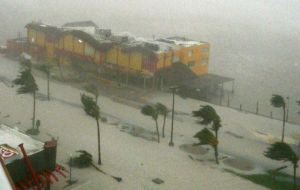MercoPress. South Atlantic News Agency
Hurricane Dean strengthens into a Category 5 storm
 Hurricane Dean reach coasts of Mexico and Belize
Hurricane Dean reach coasts of Mexico and Belize Hurricane Dean strengthened into a monstrous Category 5 storm Monday night as its outer bands of wind and rain slammed the coasts of Mexico and Belize. Thousands of tourists fled the beaches of the Mayan Riviera as it roared toward the ancient ruins and modern oil installations of the Yucatan Peninsula.
Mexico's state oil company, Petroleos de Mexico, said it was evacuating all of its more than 18,000 offshore workers in the southern Gulf of Mexico, which includes the giant Cantarell oil field. Dozens of historically significant Mayan sites also were emptied. Dean, which has killed at least 12 people across the Caribbean, quickly picked up strength after brushing Jamaica and the Cayman Islands. By 2 a.m. EDT, Dean had sustained winds of 160 mph and was centered about 100 miles east of Chetumal, where it was projected to make landfall early Tuesday, according to the U.S. National Hurricane Center. Chetumal is about 120 miles south of Tulum. Category 5 storms 'capable of catastrophic damage' are extremely rare. Only three have hit the U.S. since record-keeping began. Cancun seemed likely to be spared a direct hit, but visitors abandoned its swank hotels to swarm outbound flights. Officials evacuated more rustic lodgings farther south. A hurricane warning was in effect from Cancun all the way south through Belize. All hospitals were closed in Belize City, the country's biggest, and authorities urged residents to leave, saying Dean is too strong for their shelters. Meteorologists said a storm surge of 12 to 18 feet was possible at the storm's center. The storm was expected to slash across the Yucatan and emerge in the Gulf of Campeche, where Petroleos de Mexico decided Monday to shut down production on the offshore rigs that extract most of the nation's oil. President Felipe Calderon said he would cut short a trip to Canada where he is meeting with President Bush and Canadian Prime Minister Stephen Harper. Shutting the 407 oil wells in the Campeche Sound will result in a production loss of 2.7 million barrels of oil and 2.6 billion cubic feet of natural gas a day, Pemex said. Of that, about 1.7 million barrels of oil a day is exported from three Gulf ports, where Pemex was loading the final tankers before shutting them as well. Central Mexico was next on the storm's path, though the outer bands were likely to bring rain, flooding and gusty winds to south Texas, already saturated after an unusually rainy summer. The Quintana Roo state government said about two-thirds of the 60,000 tourists in the Cancun area had left. Some camped overnight at the city's airport to ensure a flight out. Many others were turned away. Workers hammered plywood over the windows of hotels along the tourist strip, where the skyline is still marked with cranes used to repair the damage of Hurricane Wilma. That storm caused $3 billion in losses in 2005. Dean could be even stronger than Wilma, which stalled over Cancun and pummeled it for a day. The fast-moving Dean was passing farther south, and was likely to deliver a brief but powerful punch to Mexico's Maya heartland. That area stretches from Tulum south to the growing beach resort at Mahahual, where authorities evacuated hundreds of tourists on Monday. Between the two lies the 2.5 million-acre Sian Kaan nature reserve, with a 1,200-year-old network of Mayan canals. Belize, just south of Mexico, evacuated 6,000 people from the country's main tourist resort, San Pedro on Ambergris Caye, and 500 or so from nearby Caye Caulker, said national emergency coordinator James Jan Mohammed. People were urged to leave low-lying areas. Authorities evacuated Belize City's three hospitals and were moving high-risk patients to the inland capital, Belmopan, founded after 1961's Hurricane Hattie devastated Belize City. Belize City Mayor Zenaida Moya urged people to leave, saying shelters aren't strong enough to withstand a storm of Dean's size. Dean, the first hurricane of the Atlantic season, raked Jamaica and the Cayman Islands on Sunday, but both escaped the full brunt of the storm. In Jamaica, the storm uprooted trees, flooded roads and collapsed some buildings. Downed utility poles left thousands without electricity or telephone service. Police said two men were killed: one when his house collapsed and another struck by flying debris. Haitian officials on Monday reported two more deaths from the storm, raising the storm's death toll in the Caribbean to at least 12. The worst storm to hit Latin America in modern times was 1998's Hurricane Mitch, which killed nearly 11,000 people and left more than 8,000 missing, most in Honduras and Nicaragua.




Top Comments
Disclaimer & comment rulesCommenting for this story is now closed.
If you have a Facebook account, become a fan and comment on our Facebook Page!